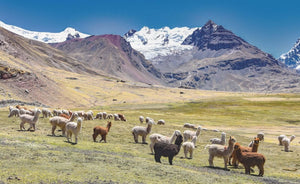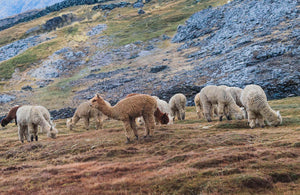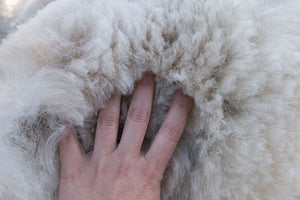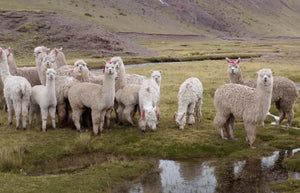Alpaca
Warm, soft and valuable. As one of the rarest, most beautiful and most valuable fibers in the world, alpaca is also known for its incomparable softness and special heat-retaining properties. It is also increasingly seen as a more sustainable alternative to the oversaturated cashmere market. Find out everything you need to know about these wonderful animals, their origins and their unique fur.

The origin
The history of alpacas has a long tradition dating back 6000 years. Even the royal families of the Incas domesticated the peaceful animals and revered them for their unique fur and the special characteristics of alpaca fiber.
Even today, alpacas are still the sanctuary of Peru. Their wool provides a livelihood for many Peruvian farmers. Around 90% of the world's 4 million animals live in the Peruvian Andes. Alpacas are usually kept in small herds of 80 to 100 animals, at altitudes of up to 5000 meters.

The properties
Alpacas are sociable herd animals. They live between 15 and 20 years, their back height is around one meter and they can reach a weight of up to 60 kg.
There are two types of alpaca, the huacaya and the suri, which differ only in their coat structure. While the huacaya's hair is short, slightly curly and very densely arranged, the suri's coat is characterized by long, curly and silky hair, whose unique light reflection creates a beautiful, natural shine.

The fiber
Due to their natural habitat, alpacas are often exposed to extreme environmental conditions and high temperature fluctuations.
The sustainable fur of alpacas is optimally adapted to these conditions: the hairs are particularly fine and closely arranged to provide sufficient protection against cold and extreme weather. At the same time, the fiber is hollow on the inside and has a heat-insulating effect thanks to its special thermal properties - a unique fiber property that regulates temperature differences of up to 25 degrees in a single day.
These properties make alpaca fiber one of the most sought-after raw materials in the world. Alpaca fiber contains hardly any lanolin (wool grease) and is therefore dust, dirt and sweat repellent. Wool and fur are therefore also ideal for allergy sufferers, babies and even the most sensitive skin.

The quality
Our partners and producers in Peru are hand-picked and specialize exclusively in alpaca fur and wool. This enables us to ensure the highest quality level of our products. We only use Royal Alpaca for our alpaca fur products and Ultrafine Alpaca for our wool collections. The quality of alpaca fibers is traditionally measured by the fiber thickness. The thinner the fiber, the finer the fur and the greater the wow effect when you touch it for the first time.

The care
Alpaca products are easy and uncomplicated to care for. Due to the special nature and natural robustness of the fur, alpaca products made of fur rarely need to be cleaned without fear of damage.
In order to maintain the unique properties of the alpaca fiber, we recommend shaking out larger products in the fresh air from time to time and, if necessary, gently vacuuming the alpaca fur. For smaller products, regular brushing with a wire fur brush is sufficient to maintain the natural shine. This applies in particular to products made from Suri fur. Professional cleaning is recommended for coarse soiling.







